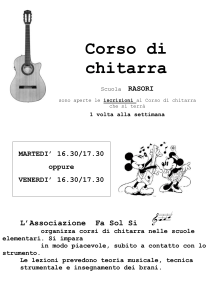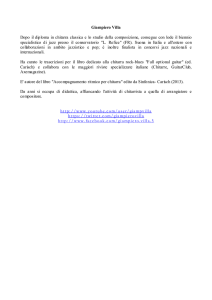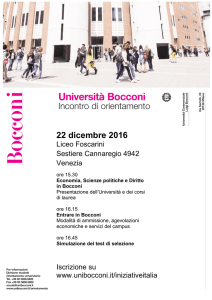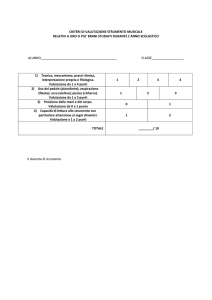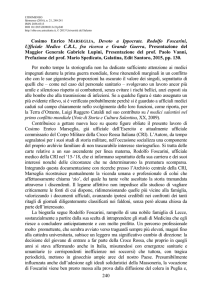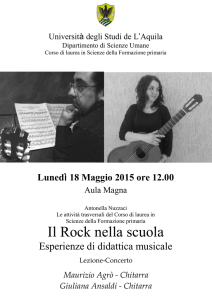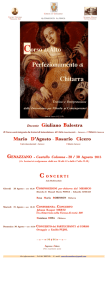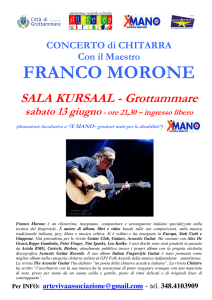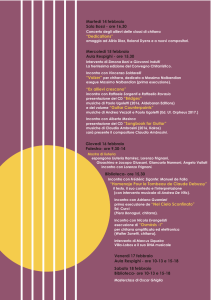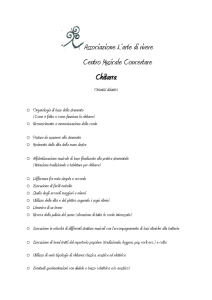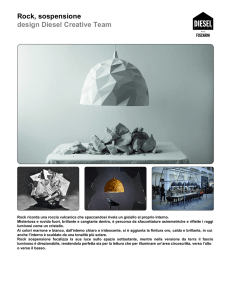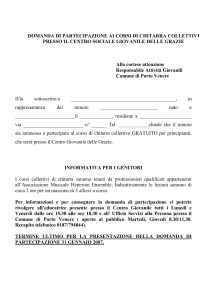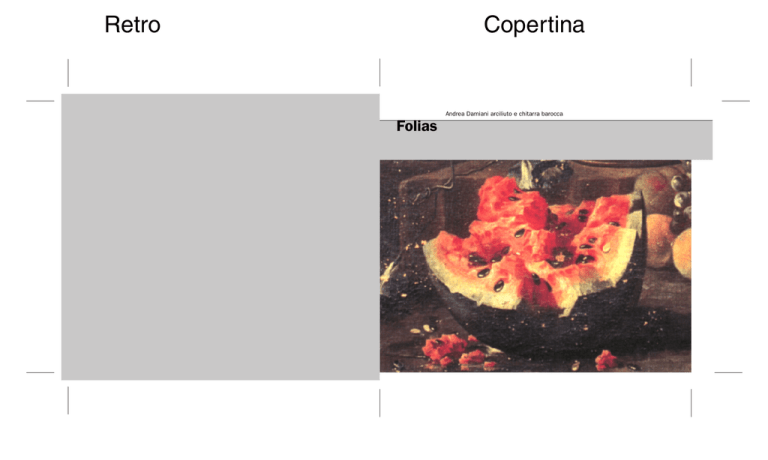
Retro
Copertina
Folias
Andrea Damiani arciliuto e chitarra barocca
Regione Marche
Provincia di Macerata
Comune di Macerata
Comune di San Ginesio
Poltrona Frau
Fondazione Carima
Folias
Andrea Damiani
arciliuto
e chitarra barocca
composizioni di
Giovanni Paolo Foscarini
Antonio Flammini Marchetti
Santino Garsi da Parma
Anonimo
Lorenzino del liuto
Stefano Pesori
(?) Onofri
Arcangelo Lori
Giuseppe Baglioni
Gerolamo Kapsberger
Le musiche The music
Santino Garsi da Parma
(1542 - 1604)
1. Balletto
Giovanni Paolo Foscarini (?-?)
2. Folias sopra l’L
3. Baletto detto l’Imperiale
4. Gagliarda detta la Manzona 5. Tromba del Foscarini
6. Passacaglio p[er] E
del Foscarini
7. Ciaccona p[er] C Foscarini
8. Alemanna Foscarini
9. Corrente Foscarini
10. Sarabanda
Antonio Flammini Marchetti
(?-?)
11.Ballo di Mantova p[er] E
Anonimo
12. Gagliarda francese
Lorenzino del liuto (?-?)
13. Gagliarda del Cavaliere
del liuto
2
Indice Index
1’12”
1’41”
0’37”
0’43”
4’44”
3’44”
3’35”
1’21”
0’57”
1’42”
1’15”
2’22”
1’43”
1’41”
Anonimo
14 Corrente francese
Stefano Pesori (?-?)
15. Il Ricci Balletto Giovanni Paolo Foscarini
16.Toccata 21
17.Passacaglio Spagnolo
18. Toccata Musicalle detta
la Fedele
(?) Onofri (?-?)
19. Passagallo dell’Onofri
Arcangelo Lori (? - 1679)
20.Toccata del Sig. Arcangelo
Giuseppe Baglioni (?-?)
21.Corrente
22.Toccata
23.Corrente
24.Gagliarda
25.Corrente
Gerolamo Kapsberger
(ca. 1580 - 1651)
26.Gagliarda 11
0’54”
5’51”
0’49”
1’22”
6’38”
1’51”
1’23”
1’54”
1’22”
1’10”
0’57”
1’24”
2’03”
7’19”
Le musiche
Il progetto
Franz Werner Tamm
Nino Ricci
12
The music
The project
12
16
Franz Werner Tamm
Nino Ricci
17
Folias
Andrea Damiani
10
Folias
Andrea Damiani
20
Fonti
Colophon
34
Sources
Colophon
34
14
36
15
36
Il progetto The project
I Comuni di Macerata e San Ginesio in collaborazione con la Provincia
di Macerata e la Poltrona Frau di Tolentino hanno permesso la realizzazione
di un progetto di ricerca avviato nel 1999 nell’ambito della manifestazione
“Resonanze”. Tale manifestazione venne promossa dalla Fondazione Carima
in collaborazione con l’Associazione Macerata Opera ed il Centro per i Beni
Culturali per lo studio delle fonti e la restituzione esecutiva del patrimonio
musicale marchigiano del Seicento.
Obiettivo del progetto era quello di studiare antichi manoscritti musicali
rinvenuti in alcune biblioteche private del territorio, integrando così l’importante
patrimonio musicale marchigiano finora riscoperto e riproporlo al pubblico di
oggi. L’incisione discografica Folias è il risultato di tale ricerca e viene a ridar
vita ad una parte del repertorio barocco per strumenti a pizzico quali chitarra
barocca, arciliuto e chitarrone sviluppatosi in ambiente maceratese. L’interpretazione delle musiche e l’approfondita ricerca musicologica è stata affidata ad
Andrea Damiani, uno dei più riconosciuti specialisti e studiosi di questo repertorio.
La presenza della Regione Marche nel settore dello studio e della diffusione
del patrimonio musicale marchigiano è una realtà ormai consolidata che ha
prodotto ricerche, pubblicazioni, interventi operativi: dal restauro degli organi
storici e alla relativa pubblicazione, all’edizione critica del dizionario dei musicisti
marchigiani del Radiciotti, di censimento delle fonti musicali, ai concerti di brani
inediti di autori marchigiani.
La Regione Marche è pertanto intervenuta a sostegno della presente edizione
discografica che è pienamente coerente con l’attività istituzionale di valorizzazione svolta dall’Amministrazione. Tale intervento si aggiunge a quelli già operati a
sostegno del prezioso lavoro di ricerca condotto dall’etichetta E lucevan le stelle
Records contribuendo alla pubblicazione e diffusione dei CD: J’ay pris Amour,
Quella vermiglia rosa, Vola de Libano.
4
The city authorities of Macerata and San Ginesio, together with the Province
of Macerata and the Poltrona Frau company of Tolentino, have contributed to
the successful completion of a research project which began in 1999 as part
of the “Resonanze” programme. “Resonanze” was initially promoted by the
Fondazione Carima, the Associazione Macerata Opera and the Centro per i
Beni Culturali to encourage the study of seventeenth century musical sources
in the Marches and to provide a platform for its performance.
The principal aims of the project were to study ancient musical scores in
various private collections in the area, thus completing a survey of the important
sources which had already been discovered, and provide the opportunity for
contemporary audiences to enjoy this important musical heritage.
The CD Folias is one of the results of this project. It highlights an important
aspect of Baroque music in the area around Macerata: the repertoire for plucked
instruments, such as the Baroque guitar, the archlute and the chittarone. The
performance of the music and the underlying musicological research were
entrusted to Andrea Damiani, one of the most widely recognised authorities
and scholars in this particular branch of musical study.
Research concerning the musical heritage of the Marches is now a wellestablished fact which has produced scholarly articles, publications, restoration
projects aimed at conserving historical instruments, a critical edition of a
dictionary of musicians in the Marches by Radiciotti, a census of musical
sources, and concerts of previously unknown music by local musicians.
For this reason, the Regione Marche lends its full support to the edition
published on this CD, which is consistent with its institutional activities of
promotion and evaluation. In the past, similar support was provide for the
precious research conducted by E lucevan le stelle Records with contributions
towards the publication and diffusion of the CDs: J’ay pris Amour, Quella
vermiglia rosa, and Vola de Libano.
Franz Werner Tamm
Nino Ricci
6
Leone Pascoli, nel 1736, diede alle stampe in Roma la “Vita de’ Pittori,
Scultori ed Architetti moderni”; a pag. 368 inizia il capitolo dedicato alle “Vite
di Francesco Vernertam”. Viene così narrata tutta la lunga permanenza romana
del pittore tedesco durante la quale si trasformò da pittore di storie religiose in
raffinato “decoratore” ed inventore di composizioni “dove, frutte, fiori, ed animali
morti rappresentare”.
Affermatosi sulla scena romana, fu a Bologna, Firenze, Ferrara e Venezia.
Inviò opere in Inghilterra, Olanda, Germania, trasferendosi poi a Vienna intorno al
1701 al servizio dell’imperatore Leopoldo per passare infine, tra il 1707 e il 1711,
a lavorare per il principe di Liechtenstein. A Roma conobbe e frequentò gli artisti
più in vista dell’epoca, come Jan Franz Van Bloemen, Gaspar Van Wittel e Carlo
Maratta con il quale eseguì opere a quattro mani.
Il particolare riprodotto in copertina appartiene a un quadro della collezione
del Comune di Pesaro. Trattasi di un olio su tela di cm 135x96 raffigurante una
composizione di fiori e di frutta la cui opulenza e ricchezza descrittiva si ricollegano
alle opere di Karel Van Vogelaer, detto Carlo de’ Fiori. La sua opera si caratterizza
per una composizione molto equilibrata nella disposizione dei volumi e dei toni,
e ricca nei dettagli che narrano una storia tutta interna all’opera. La presenza dei
putti e del paesaggio anima ancor più la scena conferendogli una grande vivezza
che per certi aspetti l’avvicina alla natura morta napoletana, senza avere di essa
il linguaggio sapido e dialettale.
La pittura del Tamm è limpida, luminosa, a volte tagliente, nelle luci e nei
brillii che si rincorrono per tutta la composizione dove ogni cosa è a fuoco pur nel
giuoco del chiaroscuro. Le pennellate rotolano brillanti e scandite nella loro lucida
sapienza come le note da una tastiera nel pieno della cultura Rococò.
Nelle pagine seguenti
In the following pages
Franz Werner Tamm
detto Daprait
(Amburgo 1658 Vienna 1724)
Natura morta
di fiori e frutta,
Still life with fruit
and flowers
olio su tela,
oil on canvas
cm 135x96,
Inv. Gen. Polidori,
n. 4038
In 1736, “Vita de’ Pittori, Scultori ed Architetti moderni” was published in
Rome by Leone Pascoli. On page 368 he begins a new chapter by relating the life
of “Francesco Vernertam.” The German painter is reported to have lived in Rome
for a long period of time. Starting out as a painter of religious subjects, he was
known later on for his refined “decorations,” and was recognised as the inventor
of a type of composition featuring “fruit, flowers and the corpses of animals.” After
making a name for himself in Rome, he went on to work in Bologna, Florence, Ferrara and Venice. He also sent pictures to England, Holland and Germany, before
moving to Vienna in about 1701, where he served at the court of the Emperor,
Leopold I. Between 1707 and 1711 he was employed at the court of the Prince
of Liechtenstein. While in Rome, he had been one of a prominent group of artists, including Franz Van Bloemen, Gaspar Van Wittel and Carlo Maratta, and had
worked on joint projects with all of them.
The detail reproduced on the cd cover is from a painting which forms part of
the city collection of Pesaro. The subject, a still life of fruit and flowers, is of such
opulence and descriptive richness that we cannot fail to make connective links
with the work of Karel Van Vogelaer, known as “Charles of the flowers.” His work
is marked by balanced disposition of volume and tonality, and rich details which
tell the story contained within the subject of the painting. The presence of cherubs
and landscape animate the scene, reflecting certain aspects of still life painting
in Naples, while carefully avoiding hackneyed stereotypes. The painting of Tamm
is clear, bright, sometimes incisive in its play of light and dark. Every single item
is sharply detailed, even where the chiaroscuro is most strongly accentuated. The
brush-strokes are applied with all the speed and grace of rippling notes from a
keyboard at the height of the Rococò.
8
F o Andrea Damiani
10
Il repertorio per strumenti a pizzico a Macerata e nelle marche del ‘600.
Il mondo degli strumenti a pizzico nell’Italia del ‘600 si presenta con un panorama estremamente vario; e ciò in contrasto con la sostanziale unità propria del
secolo precedente, dove il liuto aveva fatto da protagonista rimanendo sostanzialmente invariato e dove la chitarra esisteva ancora in forma embrionale. Le ragioni
della trasformazione e dell’invenzione di nuovi strumenti che avvengono a partire
dalla fine del ‘500 si spiegano con le mutate esigenze musicali e con il diffondersi
di nuove mode. La ‘moderna’ musica impostata sul canto accompagnato richiede
maggiori possibilità sonore per concertare il basso continuo all’interno di gruppi
quasi interamente formati a tale fine (va ricordato che nelle prime orchestre
dell’opera e dell’oratorio gli strumenti armonici rappresentavano la maggioranza
rispetto a quelli melodici): quindi una più ampia estensione nel registro basso,
sostegno armonico e volume sonoro. D’altra parte anche la musica contrappuntistica, che specialmente nell’ambito sacro continua ad essere praticata durante
tutta l’epoca barocca, si piega all’uso del continuo, rendendo indispensabili gli
strumenti a pizzico all’interno degli organici delle cappelle musicali.
Nel nuovo secolo il liuto viene dunque sottoposto ad una serie di modificazioni,
sia morfologiche che tecniche, che lo adattano a queste esigenze. Il risultato è
l’invenzione della tiorba e dell’arciliuto. Uguali nell’aggiunta di un secondo manico
che ne prolunga l’estensione in basso di un’ottava, i due strumenti si differenziano
per la resa sonora: grave e piena quella della prima, acuta e brillante nel secondo.
E per il carattere musicale: espressivo e drammatico la prima, contrappuntistico
e decorativo il secondo. Tra i due la tiorba sembra avere la meglio per la versatilità nell’accompagnamento e la sonorità più ricca. Ma accanto alla tiorba
compare uno strumento nuovo: la chitarra. Approdata all’inizio del ‘600 come
piccolo strumento a quattro corde, la chitarra si afferma grazie ad un vantaggio
indiscutibile: la facilità. Proposta attraverso decine di piccoli libri che scavalcano
le difficoltà della teoria musicale grazie ad un rivoluzionario e semplice sistema
grafico, la chitarra ‘spagnola’, perché è dalla penisola iberica che inizia questo
viaggio fortunato, si impone come lo strumento più in voga per l’accompagnamento
delle canzoni con lo stile degli accordi ‘battuti’, percuotendo insieme i cinque cori
con le dita della mano destra.
La moda spagnola, che si manifesta anche attraverso la foggia del vestire, farà il
resto: in pochi anni danze come la sarabanda, la passacaglia e la ciaccona sono presenti ovunque, particolarmente in Italia e Francia. Ciò aiuta la creazione di un repertorio
solistico originale dove il semplice stile ‘battuto’ delle canzoni diventa una tecnica più
ricca ed elaborata. Un ulteriore impulso arriva poi dal liuto e dalle sue ascendenze
colte e polifoniche: la chitarra adotta un linguaggio che unisce allo stile accordale le
possibilità melodiche e contrappuntistiche date dalle corde pizzicate singolarmente
alla maniera del liuto.
Il risultato è uno stile ‘misto’ ricco di effetti nuovi che uniscono alle caratteristiche
ritmiche peculiari della chitarra le formule compositive e di ornamentazione proprie del
liuto e della tiorba. La fortuna della chitarra e della tiorba viene così testimoniata da un
uomo di cultura come Vincenzo Giustiniani: “Era anche in passato molto in uso il suonare
di Liuto; ma questo stromento resta quasi abbandonato affatto, doppoiché s’introdusse
l’uso della Tiorba, la quale essendo più atta al cantare anche mediocremente e con
cattiva voce, è stata accettata volentieri generalmente, per schivare la gran difficoltà,
che ricerca il saper sonare bene il Liuto. Tanto più che nell’istesso tempo s’introdusse
la chitarra alla Spagnola per tutta Italia, massime in Napoli, che unita con la Tiorba,
pare che abbiano congiurato di sbandire affatto il Liuto; et è quasi riuscito a punto,
come il modo di vestire alla Spagnola in Italia prevale a tutte le altre foggie”. (Vincenzo
Giustiniani, Discorso sopra la musica de’ suoi tempi [1628]) In realtà Giustiniani tende
ad evidenziare la novità rappresentata dalla comparsa dei nuovi strumenti nonché il
loro utilizzo da parte dei dilettanti: il liuto e l’arciliuto continuano ad essere utilizzati
negli ambiti più vari, da quello della musica d’insieme (basso continuo e concertato
con altri strumenti) a quello solistico.
Inoltre il rapporto che si genera tra questi strumenti e i musicisti che li suonano
appare quanto mai ricco e vario: la figura del polistrumentista si fa sempre più strada,
basti ricordare le figure di esponenti di spicco della scuola romana come Lelio Colista e
Gerolamo Kapsberger. Così come è vero che i primi chitarristi, ancora alla ricerca di una
tecnica e di uno stile, mostrino una sorta di soggezione e di indebitamento nei confronti
dei maestri del liuto dai quali prendono in prestito spunti musicali, tecnici ed espressivi
Il presente programma è dedicato alla musica solistica per chitarra, arciliuto e tiorba
tratta da fonti conservate in alcune biblioteche marchigiane e dell’Italia centrale: con
l’intento di mostrare sia l’aspetto professionale, con il repertorio più impegnativo,
che quello dilettantesco, che con la pratica musicale casalinga costituiva una delle
occupazioni preferite sia del nobile che del borghese. I documenti relativi alle famiglie
patrizie, specialmente romane, mostrano che tra il personale mantenuto alle proprie
dipendenze è spesso presente la figura del musicista con l’incarico di compositore,
organizzatore di eventi, esecutore in rappresentazioni teatrali, sacre, in concerti privati, precettore musicale per i membri della famiglia. Basti ricordare, solo per citare i
nomi più famosi, il mecenatismo esercitato dai Barberini, i Doria-Pamphili, i Ruspoli.
L’attività musicale nella provincia, e in particolare nelle Marche, appare oggi meno
evidente, sia perché non è stata ancora effettuata una ricerca di livello pari a quella
riservata ai centri più importanti, sia per la probabile scarsità di avvenimenti musicali
paragonabili a quelli promossi nelle grandi città. Ma una realtà diversa sta lentamente
venendo alla luce: basti qui ricordare l’importanza della Cappella musicale di Loreto,
dove lavorarono Antonio Cifra e Pietro Pace; o musicisti come Bartolomeo Barbarino
da Fabriano o Giacinto Cornacchioli di Ascoli, che dopo gli studi nelle loro città alternarono momenti di attività in centri come Padova, Monaco e Roma, a quello di maestri
di cappella in varie città delle Marche.
Un piccolo ma importante contributo alla conoscenza dell’attività musicale privata
nelle Marche del ‘600 viene oggi dal ritrovamento di alcune opere per chitarra nella
biblioteca dei conti Olivieri a San Ginesio. Questa collezione faceva parte dell’archivio
12
dei conti Onofri, acquisito dagli Olivieri in seguito ad un matrimonio contratto tra le
due famiglie.
La prima è un’opera a stampa (al cui interno sono inserite pagine manoscritte)
che reca due titoli diversi: Toccate / Di / Chitarriglia / Di Stefano / Pesori; e nella
pagina successiva Le Le (sic) / Danze D’apollo / Alle Muse/ Scherzi della Mano
/ Di Stefano Pesori / Ne quali si vede con bellissimo ordine descri= / tte Varie, e
vaghissime suonate / di Chitariglia / Dedicate / Al Molto Reuerendo Padre Fra Carlo
De’ Ricci da’ S. Genesio Rispondete / Nello Studio di Verona l’Anno 1659 / In, S,ta
Eufemia. Segue la dedica, manoscritta e datata “Verona il 27 Maggio 1659, in
cui l’autore si augura che “più aggievolmente ella possa talvolta alternare le armoniche proportioni della musica alle regolate sinfonie dell’eloquenza” alludendo
agli interessi musicali e letterari del Ricci.
Stefano Pesori, mantovano, è noto per aver dato alle stampe altri cinque libri
di intavolature di ‘chitarriglia’, tra il 1648 e il 1650 a Mantova e Verona.
Il libro sembra essere il frutto dell’assemblaggio di materiali già esistenti:
ad esempio vi si ritrovano diversi brani presenti ne Lo Scrigno Armonico ma con
dediche differenti: intercalati a questi si trovano alcune pagine manoscritte che
dovrebbero costituire il materiale preparato appositamente per l’occasione. Tra
i brani musicali si trovano dei brevi componimenti letterari. Una “Lettera / Di
Stefano Pesori / In cui s’adita un sicuro sentire, per chiunque brama istradarsi
alla felicità dell’amore”; dei sonetti dedicati al Pesori da suoi conoscenti e seguiti
dalla sua risposta; un “Secreto rarissimo per fare i capelli neri”. Di particolare
interesse il “Registro / Delle Persone / Piu Riguardevoli, / Che hanno honorato
ed honorano, / Questa Armoniosa Virtu, / Sotto Gl’insegnamenti Del / Pesori”. Un
elenco di allievi ordinato secondo la gerarchia sociale: “Nobili veneti, Marchesi,
Conti, Dottori, Religiosi, Gentiluomini, Capitani, Cittadini, Mercanti, Tedeschi,
Ebrei”, una preziosa testimonianza sulla diffusione della chitarra tra i dilettanti
e sul mestiere di insegnante.
La musica di Pesori è scritta in intavolatura italiana di chitarra del genere
14
‘misto’, che unisce cioè alle lettere dell’alfabeto che contrassegnano gli accordi
pieni le cifre dell’intavolatura che indicano le note da pizzicare singolarmente.
Le indicazioni ritmiche poste al di sopra sono imprecise e spesso incongruenti,
così come le stanghette di battuta solo raramente delimitano una somma di
valori corretta. Ciò va probabilmente spiegato con la iniziale impreparazione
musicale dei chitarristi seicenteschi, che ancora usavano la scrittura come
sussidio mnemonico, per sé o per gli allievi, piuttosto che come immagine fedele
dell’esecuzione.
Il materiale manoscritto presente nella biblioteca della famiglia Olivieri può
essere così descritto: - [Ms. A] È un manoscritto cartaceo, rilegato in cartone,
oblungo, misura cm 20,5x13 e consta di 36 carte; ognuna con cinque pentagrammi. Contiene 36 brani scritti in intavolatura italiana ‘mista’ di chitarra. Gli
autori presenti sono: Giovanni Paolo Foscarini: 17 brani, Ferdinando Valdambrini:
6 brani, Paolo Zozzi detto Paoluccio della chitarra (anche Paulino in un brano):
7 brani, Antonio Flammini Marchetti: 3 brani, (?) Onofri: la variazione n° 31 del
‘Passagallo dell’Onofri p[er] la E’ contenuto nel ms. B; scritta successivamente
su due pentagrammi lasciati vuoti. Brani adespoti: 2.
Nell’ultima pagina, in cui si trova la tabella dell’alfabeto della chitarra, in
calce si legge ‘Lorenzo Cristiano’, forse il compilatore. La maggior parte dei brani
consiste in ciaccone e passacaglie; l’intavolatura è scritta con mano veloce, ma
abbastanza chiara, nella tipica calligrafia italiana seicentesca. I segni ritmici sono,
con poche eccezioni, assenti. Due brani di Foscarini concordano, con alcune
differenze, con la Corrente di p. 19 e con l’Allemanda di p. 104 dell’edizione
de Li Cinque Libri Della Chitarra Alla Spagnola pubblicata a Roma nel 1640. Gli
altri brani di Foscarini sono tutti inediti. I brani di Francesco Valdambrini invece
sono copiati, senza segni ritmici e con alcuni tagli e modifiche, dal Libro Secondo / D’intavolatura Di Chitarra / A Cinque Ordini / Di Ferdinando Valdambrini
Romano, pubblicato a Roma nel 1647. I rimanenti brani, così come i loro autori,
erano finora sconosciuti.
- [Ms. B] Si tratta di un fascicolo senza rilegatura, misura cm 17,5x24 costituito da 8 carte, probabilmente faceva parte di un quaderno più consistente. Le
prime due carte contengono dieci pentagrammi; le restanti otto. Vi si trovano 7
brani, scritti in intavolatura ‘mista’; i segni ritmici sono assenti:
(?) Onofri: 4 brani, Vezzosi senese: 1 brano, Adespoti: 2 brani - Fogli indipendenti. [Ms B-1]: una carta probabilmente proveniente dallo stesso quaderno del
Ms. B, con due brani di Onofri [Ms. B-2]: una carta oblunga, misura cm 24x16,8
con un brano di Onofri: una versione abbreviata del Passagallo p[er] la E dell’Onofri. - [Ms. C]: “Sonate di Mandola diverse”; oblungo, misura cm 15x11, consta di
tre carte. Contiene 10 brevi brani per mandola.
I manoscritti sembrano essere stati redatti da tre mani diverse; una per il Ms.
A, una per i Mss. B, simile alla precedente, una per il Ms. C. Per quanto riguarda il
Ms. A le concordanze con la stampa di Valdambrini suggeriscono una datazione
vicina alla metà del secolo, mentre i brani di Foscarini rendono, come vedremo,
la questione più problematica. Per quanto riguarda i Mss. B si presume un’epoca
più tarda rispetto ad A, dove la variazione del Passagallo di Onofri copiata da B
è stata aggiunta sicuramente in un secondo tempo.
L’interesse di questo materiale manoscritto appare subito evidente per
molteplici ragioni. Riporta alla luce musica inedita di Giovanni Paolo Foscarini,
un chitarrista molto considerato alla sua epoca, di cui oggi si sa troppo poco,
consentendo inoltre di ipotizzare un suo ulteriore collegamento, oltre quelli già
noti, con l’ambiente marchigiano. La raccolta contiene inoltre composizioni di
autori altrimenti sconosciuti, il più interessante dei quali è l’Onofri, un antenato
non ancora identificato della famiglia che ha conservato fino ad oggi i manoscritti.
La storia nota di Foscarini è per ora desunta dalle dediche dei suoi libri e da poche
altre notizie. Dopo un periodo di servizio alla corte di Bruxelles presso Alberto VII
d’Asburgo (non oltre il 1621, data della morte di questi), dove probabilmente viene
in contatto con alcuni liutisti della scuola francese, lo ritroviamo in Ancona: qui nel
1624 viene fondata da Prospero Bonarelli della Rovere, in occasione dell’elezione
di Maffeo Barberini come Urbano VIII, l’Accademia dei Caliginosi, di cui Foscarini
diventa membro col nome di Furioso. Secondo Paolini “L’impresa raffigurava un
orso in piedi, appoggiato ad un tronco di lauro, nell’atto di farsi pungere gli occhi
e la lingua da uno sciame d’api. Il motto era ‘acuunt vulnera visum’”. Lo stemma
allude all’orso che ricerca la puntura dell’ape per farsi liberare gli occhi cisposi:
allo stesso modo la magnificenza dei Barberini (simboleggiati dall’ape) risveglia la
creatività dell’artista. Non è escluso che Foscarini partecipasse direttamente alla
fondazione dell’Accademia: la parola ‘caliginoso’ richiama chiaramente ‘fosco’ e
Foscarini. Inoltre i rapporti con Prospero Bonarelli dovevano essere stretti se nella
sua opera seconda gli dedica un brano, il ‘Baletto detto l’Imperialle’ chiamandolo
‘Patron Colendissimo’. È infatti a Macerata che pubblica l’intavolatura / Di Chitarra
Spagnola, / Libro Secondo, nel qual si contiene Passacalli semplici e Passeggiati,
Folie, Pass’e / mezzi, Gagliarde e altre sonate concertate a due e tre / chitarre
differenti… Del Accademico Caliginoso detto il Furioso, nuovamente composto e
dato in luce, / e dedicato / Al Molto Illustre Signore / Iulio Francesco Brancaleone
/ In Macerata, Appresso Gio. Battista Bonomo, 1629. Alla fine del libro si legge:
“Dell’Accademico Caliginoso, detto il Furioso, Musico, e sonatore, / di Liuto, e Tiorba,
della Venerabile Compagnia del / Santissimo Sacramento d’Ancona”, che doveva
essere una delle tante confraternite seicentesche che avevano funzioni caritative
o di assistenza sociale.
Foscarini continua a celare il suo vero nome fino alle ultime pubblicazioni, dove
finalmente firma alcune dediche, continuando però ad apparire sui frontespizi con lo
pseudonimo. Sorgono a questo punto i primi interrogativi. Era originario delle Marche?
Perché nascondeva il suo nome? Allo stato attuale delle conoscenze è possibile solo
fare delle ipotesi. Il nome Foscarini è quello di una delle più antiche e nobili famiglie
veneziane, che in quegli anni annoverava diplomatici e addirittura un doge. In una
delle sue pubblicazioni più tarde (1640), nella dedica a Carlo di Lorena egli ricorda
16
“la divotissima osservanza e servitu prestata a Vra Eccellenza dalli miei antenati
nell essercitio militare sotto le sue vittoriose bandiere”. È quindi possibile che egli
appartenesse ad un ramo secondario della famiglia, e che fosse costretto a celare il
suo mestiere, considerato poco consono ai ranghi più elevati della società. Sembra
poi esistere, anche grazie alla raccolta ritrovata, un collegamento tra il Veneto e le
Marche. Fra’ Carlo Ricci, dedicatario del libro di Pesori, vive a Verona nel convento
di S. Eufemia; ma probabilmente in seguito si trasferisce a San Ginesio, sua città
natale, e porta con sé il libro: che per qualche motivo passa all’Onofri, nobile dilettante
di chitarra, nel cui archivio rimane fino ad oggi. Anche Foscarini ha a che fare con
Verona e Venezia. Il suo ritratto, stampato in alcune opere, è accompagnato da una
quartina ‘In lode dell’Autore’ composta da Orazio Abbaco, Gentiluomo Veronese’. Uno
dei suoi ultimi libri è pubblicato a Venezia. È dunque ipotizzabile che abbia conosciuto
il Ricci, appassionato dilettante di chitarra, forse a Verona, forse durante il soggiorno
marchigiano: il ms. A potrebbe essere legato a questa conoscenza.
Foscarini comunque non limitò la sua attività alle Marche. Potrebbe essere infatti
lui il Giovanni Paolo che suona la chitarra nella rappresentazione sacra I Santi Didimo
e Teodora negli anni 1635 - 1636 a Roma. Gaspar Sanz, autore di un noto manuale
di chitarra pubblicato più volte nel ‘600, lo annovera tra i maestri romani di questo
strumento. Successivamente torna ad essere presente in varie corti europee. Due
fatti lo legano a Parigi. La pubblicazione della traduzione di un trattato del matematico
e astronomo G. Keplero: Dell’Armonia del mondo lettioni due (1647). Una lettera a
C. Huygens, il noto diplomatico e uomo di cultura che ebbe rapporti epistolari con
diversi musicisti, il quale aveva intenzione di acquistare un liuto italiano. Foscarini
risponde (1649) che in Italia possiede non meno di cinque liuti di Laux Maler (uno
dei maggiori esponenti della scuola bolognese del ‘500), trovati nel guardarobba
del Duca di Urbino.
L’opera di Foscarini costituisce una testimonianza concreta della crescita della
chitarra nel 600’. Le sue prime composizioni si limitano a ripetere le formule tipiche
delle danze più in voga: la Passacaglia, la Ciaccona, la Sarabanda. Ma lo stesso Libro
secondo contiene una serie di brani che, sempre nei limiti degli accordi pieni propri
della scrittura alfabetica, mostrano uno sviluppo melodico più interessante ottenuto
ricercando i vari accordi nelle posizioni più acute. La fase successiva consiste nell’aggiungere le note singole alla maniera del liuto: questo è il tipo di scrittura adottato nel
Ms. A, dove si aggiungono nuove possibilità tecniche e melodiche.
Di particolare interesse in questa fonte è l’elaborazione armonica adottata
nelle passacaglie e nelle ciaccone: basata sull’invenzione di nuovi accordi che via
via si sostituiscono a quelli più usuali. Oltre a questo aspetto tipicamente italiano
si riconosce spesso l’eco della musica francese. Lo stadio più maturo dello stile di
Foscarini è invece rappresentato dalla Toccata, dove fa suoi gli aspetti più tipici della
musica strumentale italiana con una scrittura che ricorda Frescobaldi e Kapsberger:
mantenendo comunque le peculiarità della chitarra con l’introduzione di sezioni ad
accordi pieni ribattuti.
La storia di Foscarini è interessante anche riguardo ai rapporti con il liuto e la
tiorba. Come si è visto egli si professa, nel 1629, suonatore di questi strumenti. Già nel
Terzo libro (senza data) inserisce ‘alcune sonate picicate al modo di leuto’, cioè scritte
senza gli accordi pieni, quasi per nobilitare un opera per sola chitarra: “Delle Sonate,
dette Pizzicate, non ne parlo più che tanto, hauendole poste più per abbellimento
dell’opera, che per altro rispetto; porche so benissimo esser più proprie del Leuto,
che della Chitara; del qual Instrumento veramente facio profesione”. Nel 1649 tenta
di vendere cinque liuti di Laux Maler a Huygens! Sfortunatamente nulla si sa degli
altri autori rappresentati nei manoscritti: di particolare interesse la figura di Onofri, la
cui lunga passacaglia è un notevole esempio di scrittura idiomatica per la chitarra.
Nonostante lo sviluppo crescente della chitarra sia evidente in questo periodo,
il liuto, oltre che nella musica d’insieme, continua ad essere praticato anche a livello
personale e solistico. Prova di ciò sono soprattutto i numerosi manoscritti conservati
nelle biblioteche italiane e straniere. Il repertorio contenuto in queste fonti si sviluppa
18
di solito in due direzioni. La tradizione italiana: con la toccata, intesa di volta in volta
come preludio, studio, brano dal contenuto espressivo e contrastante, virtuosistico;
e, nel campo delle danze, la gagliarda. La tradizione francese, che in campo liutistico
andava acquistando sempre maggiore importanza, con danze come la corrente, la
volta, il balletto. Lo stile italiano preferisce una scrittura più contrappuntistica, con
diminuzioni nel vecchio stile cinquecentesco; quello francese fa leva sul preziosismo
della sonorità, sulla frammentazione della struttura armonica nello stile spezzato.
Nell’ambito di queste fonti sono stati scelti due esempi, uno conservato a Pesaro,
l’altro a Perugia. Il primo sta nella Biblioteca del Conservatorio di Musica ‘G. Rossini’ con
la segnatura Rari Ms. b.10. Vi si trovano brani per strumenti che vanno dal liuto a sette
cori ad un arciliuto a undici cori, alla tiorba. Tra gli autori presenti vanno ricordati Santino
Garsi da Parma, il Cavaliere del liuto, e Gerolamo Kapsberger. La fonte perugina si trova
all’Archivio di Stato, Archivio Fiumi Sermattei VII H 2, e, oltre ad essere una delle fonti
principali riguardo al liutista napoletano Andrea Falconieri, contiene musiche di autori
appartenenti all’area romana: Giuseppe Baglioni e Arcangelo Lori, ‘scudiere’ del papa e
attivo per diversi anni in S. Luigi dei Francesi.
The repertoire for plucked string instruments in Macerata and the Marches
during the seventeenth century.
If we look at the world of plucked instruments in seventeeth-century
Italy, we cannot help but note an extremely varied panorama which contrasts
markedly with the substantial unity of what had gone before. The lute had
been the undisputed protagonist in the sixteenth century and its ascendancy
remained basically unchallenged, for the guitar was still in an embryonic
state. The reasons for the transformation of existing instruments and the
invention of new ones may be found in the changing musical requirements
and the new fashions which occurred from the end of the sixteenth century
onwards. The most ‘modern’ music of the day required a basso continuo of
sufficient weight within a group of instruments which served essentially to
accompany singing. Indeed, the first orchestras, whether used in performances of operas or oratorios, employed more instruments in a harmonic
than in a melodic role. Contrapuntal music continued to be performed during the Baroque period, especially in religious circles, and it also required
a continuo, so that plucked instruments became an indispensable part of
any cappella musicale.
In the seventeenth century, the lute underwent a series of transformations both in terms of its actual shape and its technical potential which
equipped it for these new roles and resulted in the creation of the theorbo
and the arch-lute. The instruments are not dissimilar in appearance, having both acquired an extension to the fret-board which extends the bass of
each by an octave, although they are different in terms of the sound which
they emit. While the first is deep and resonant, the second is sharp and
brilliant in tone. Regarding their expressive characteristics, the theorbo is
expressive and dramatic, the arch-lute decorative and contrapuntal. Of the
20
two, the theorbo is the more versatile in its potential for accompaniment, as
well as in the richness of the sound which it can produce.
At the same time, a new intrument appeared alongside the theorbo: the
guitar. Launched in about 1600 as a small, four-stringed instrument, the
guitar quickly caught on for the reason that it was comparatively simple to
play. Many manuals appeared which skipped over the difficulties of musical
theory, presenting the music in the revolutionary and simple written form of
entablature. The ‘Spanish’ guitar originated in the Iberian peninsula, and it
soon became the most popular instrument for accompanying songs. It was
played by ‘striking’ chords with the fingers of the right hand. The fashion for
all things Spanish soon caught on, including the Spanish style of dressing,
while dances such as the sarabanda, the passacaglia and the ciaccona were
shortly being written and played all over Italy and France. Nor was it long
before the new style became entrenched in the form of an original repertoire
for soloists, the simple striking of chords to accompany songs giving way to
the development of a richer and more elaborate technique of playing. This was
aided by the precedent of the cultured and polyphonic lute; the guitar began
to adopt a language which combined the contrapuntal and melodic style of
plucked lute-playing with the chordal potentialities of the guitar. The ‘mixed’
style which evolved was rich in new effects which combine the rhythmical peculiarities of the guitar with the compositional formulas and the ornamentation
characteristic of the theorbo and the lute. The relative merits of the theorbo
and the guitar were noted by a man of culture, Vincenzo Giustiniani, in the
following manner: “The lute was played much in the past, but the instrument
was almost entirely abandoned after the introduction of the theorbo. Being
more suitable to singing, even poorly and with a bad voice, it was widelly
accepted as it avoided the difficulties of trying to play sweetly upon the lute.
At the same time, the guitar a la Spagnola was introduced throughout Italy,
and especially in Naples. The guitar and the theorbo together have taken
the place of the lute, just as the Spanish style of dressing prevailed in Italy
over every other fashion” (Vincenzo Giustiniani, Discorso sopra la musica de’
suoi tempi, 1628). Giustiniani tends to emphasise the emergence of new
instruments, together with their use by amateurs, while the truth is that the
lute and arch-lute continued to be employed in all forms of music-making,
including ensemble-playing (as the basso continuo or in concert with other
instruments) and as solo instruments.
The relationships between these diverse instruments and the musicians who played them appears to have been extremely rich and various.
Musicians capable of performing well on all the instruments appear to have
gained ground, and we need think only of important instrumentalists of the
Roman school, such as Lelio Colista or Gerolamo Kapsberger, if we require
evidence. At the same time, it is worth noting that the first guitarists were
still searching for a distinctive style and technique and they appear to have
been indebted to the influence of the great lutenists, from whom they borrowed not only musical ideas, but also techniques and forms of expression.
The music in this recording is dedicated to the guitar, the arch-lute and
the theorbo and it is taken from various library sources in the Marches
and central Italy, the intention being to illustrate not only the professional
aspect of public performance with its more demanding repertoire, but also
the amateur side of music-making. Domestic playing constituted one of the
favourite pastimes of both the noble and the middle-class family. Documents
concerning noble families, particularly those of Roman origin, suggest that
the household often contained at least one professional musician whose
duties included composition, organising entertainments, putting on theatrical
and religious performances, giving private concerts, as well as concerning
22
himself with the musical education of the family members. Among the more
renowned patrons of music, the names of the Barberini, Doria-Pamphili and
Ruspoli families ought to be remembered.
Musical activities in the provinces, particularly the Marches, appear
less evident today than they actually were. There are two main reasons for
this: less research has been done regarding provincial areas, and the fact
that large-scale events were rarer than those promoted in the larger cities.
However, a distinct local reality is slowly emerging. The Cappella musicale
of Loreto, for example, produced musicians such as Antonio Cifra and Pietro
Pace, while other able musicians, such as Bartolomeo Barbarino of Fabriano
and Giacinto Cornacchioli of Ascoli, learned their music in those places before moving on to work in large cities such as Padua, Munich and Rome. In
addition, there were able maestri di cappella, or choir-masters, working in a
number of cities in the Marches.
A small but significant addition to our knowledge of private musical activity
in the seventeenth century in the Marches is provided by the recent discovery
of various works for the guitar which belonged to the library of the Count
Olivieri family in San Ginesio. This collection formed part of the archive of
the Onofri family, having passed from the Olivieri family following a marriage
contracted between the two families.
The first printed work (inside which other manuscript pages have been
added) bears two different titles: “Toccate / Di / Chittariglia / Di Stefano /
Pesori” and on the following pages: “Le Le (sic) Danze D’apollo / Alle Muse
/ Scherzi delle Mano / Di Stefano Pesori / Ne quali si vede con bellissimo
ordine descri= / tte Varie, e vaghissime suonate / di Chitariglia / Dedicate
/ AL Molto Reuerndo Padre Fra Carlo De’ Ricci da’ S. Genesio Rispondete /
Nello Studio di Verona l’Anno 1659 / In, S.ta Eufemia”. A dedication was added
by hand and dated “Verona, il 27 Maggio, 1659”, and the author expressed
the wish that the dedicatee, who was well-known for his musical and literary
interests, “might by this means more easily alternate the harmonic proportions
of music to the regulated symphonies of eloquence”.
Stefano Pesori, who was from Mantova, published five other books of
entablature for the ‘chitarriglia’ in both Mantova and Venice in the years
between 1648 and 1650.
The manuscript under consideration here, however, appears to be a collection of pieces from other sources. For example, a number of the pieces are
also found in Lo Scrigno Armonico, although they bear different dedications,
and there are handwritten pages interspersed throughout the manuscript which
would seem to have been prepared especially for the occasion. Between the
musical works, some brief literary pieces are also to be found, including a “A
Letter / Of Stefano Pesori / In which a suitable path is indicated for any person
daring to seek happiness in love”, some sonnets which Pesori dedicates to his
friends and follows with his own commentaries, and a “Rare secret for colouring the hair black”. Of great interest is his “Register / Of The Most Important
Persons / Who have honoured, and continue to honour / This Harmonious
Virtue / Following The Teachings Of / Pesori”. A list of his pupils is given in
order of their social standing, “Noble Venetians, Marquises, Counts, Doctors,
Religious Orders, Gentlemen, Captains, Citizens, Merchants, Germans and
Jews”, providing important evidence of the diffusion of the guitar among amateurs and telling us a great deal about the role of the teacher. The music of
Pesori is written using Italian entablature for the guitar of a ‘mixed’ type, which
unites letters of the alphabet signifying chords to a system of numbers which
indicate those notes which are to be plucked individually. The markings placed
above the stave indicating the rhythms to be used are imprecise and often
incongruous, while the divisions marking the ends of bars rarely correspond
to their correct time values. This may well be explained by the lack of formal
24
training of seventeenth-century guitarists, who continued to use the written
notes as a rough guide rather than as an exact text to be faithfully executed.
The manuscript material in the Olivieri library may be briefly described in
the following manner:
[Ms. A] A paper manuscript bound with boards, oblong and measuring
20.5x13, which contains of thirty-six sheets of paper, each sheet consisting
of five staves. It contains 36 pieces of music written out in ‘mixed’ Italian
entablature for the guitar, and the composers are the following:
Giovanni Paolo Foscarini - 17 pieces; Ferdinando Valdambrini - 6 pieces;
Paolo Zozzi, who was known as Paoluccio della Chitarra (identified as Paulino
in one instance) - 7 pieces; Antonio Flammini Marchetti - 3 pieces.
(?) Onofri - ‘Variation n° 31 on the Passagallo dell’Onofri p[er] la E’ in
manuscript B, which is written after a blank space of two staves; unidentified
composers - 2 pieces. On the final page, a table of the alphabet for the chords
on the guitar is illustrated, and the name, ‘Lorenzo Cristiano’, is written. Cristiano may have been responsible for compiling the manuscript.
Most of the pieces are chaconnes and passacaglias, and they have been
written out quickly but relatively clearly in a script which is typical of seventeenth- century Italy. With few exceptions, indications of tempo are absent.
Two of the pieces by Foscarini are almost identical with the Corrente on p. 19
and the Allemanda on p. 104 of the edition of “Li Cinque Libri Della Chitarra
Alla Spagnola”, which was published in Rome in 1640. The other pieces by
Foscarini are all unpublished, while those attributed to Francesco Valdambrini
have been copied out without indications of tempo and with occasional slight
modifications from the versions found in “Libro Secondo / D’intavolatura Di
Chitarra / A Cinque Ordini / Di Ferdinando Valdambrini Romano”, which was
published in Rome in 1647. The remainder of the pieces, together with their
authors, were previously unknown.
- [Ms. B] This is an unbound folder measuring 17.5x24 which contains only
8 sheets of paper, although it may once have been more consistent. The first
2 sheets are written out in 10 staves, while the remainder contain 8 staves
each. Seven compositions are written out in the form of ‘mixed’ entablature,
and there are no indications of tempo. The composers are the following: (?)
Onofri - 4 pieces: Vezzosi Senese - 1 piece, unidentified composers - 2 pieces.
- Loose sheets [Ms. B1]: a sheet which probably once belonged with Ms. B.
It contains 2 pieces by Onofri.
[Ms. B2]: an oblong sheet measuring 24x16.8. It contains a shorter version of Onofri’s Passagallo p[er] la E [Ms. C]: “Sonate di Mandola diverse”.
Three oblong sheets measuring 15x11 and consisting of three sheets of paper
containing 10 short pieces for the mandola.
The manuscripts appear to have been written out by three different copyists:
one for Ms. A, a similar hand for the Mss. B, and a different hand for Ms. C.
Regarding Ms. A, the close similarity of the text with the edition published by
Valdambrini suggests that it was written out in mid-century, although the inclusion of pieces by Foscarini complicates the question, as we will see. The Mss.
B group would appear to have been compiled at a later date than Ms. A, the
variation on Onofri’s Passagallo having been certainly added as an afterthought.
The manuscript is especially interesting for a number of reasons. In the
first place, it provides us with previously unknown music composed by Giovanni
Paolo Foscarini, a guitarist who was greatly admired during his lifetime, and
about whom little is known at the present time. To the facts that are known,
we can now also hypothesise connections with the Marches. In addition, the
manuscript collection includes music by composers about whom equally little is
known. The most interesting figure in this group is certainly Onofri, an unidentified ancestor of the family which preserved the document until the present day.
The little information that we do have about Foscarini comes from the dedi26
cations to his published works, and from little else. After serving for a period
of time in Brussels at the Hapsburg court of Albert VII (certainly before 1621,
the year of Albert’s death), where Foscarini must have made the acquaintance of lutenists of the French school, we find him next in Ancona. In 1624,
to celebrate the election of Maffeo Barberini as Pope Urban VIII, Prospero
Bonarelli della Rovere founded the Accademia dei Caliginosi, and Foscarini
was one of the first members, adopting a pseudonym, as was the custom of
the time. He called himself Furioso. According to Paolini: “The emblem of the
Academy portrays a standing bear leaning against a laurel bush being stung
by a swarm of bees. The legend read: ‘acuunt vulnera visum’”. The symbol
refers to the lazy bear’s attempts to open its bleary eyes by provoking the
bees to sting it; by the same means, the magnificence of the Barberini family
(which is symbolised by the bees) awakens the creativity of the artist. Foscarini
may well have been one of the founding members of the Academy. Indeed,
the word ‘caliginoso’ (murky) recalls the origins of Foscarini’s own name, the
word ‘fosco’ meaning ‘gloomy, dim or murky’. The relationship with Prospero
Bonarelli must have been a close one, as Foscarini dedicated a piece to him in
his Libro Secondo: the piece entitled ‘Baletto, detto l’Imperialle’ is dedicated
to his ‘Patron Coledissimo’. The frontispiece to the work reads: “Entablature /
For Spanish Guitar / Second Book, containing a selection of easy Passacaglias,
Folie, Pass’e / mezzi, Gagliarde and other sonatas for two or three / diverse
guitars ... by Furioso, Member of the Academy of the Caliginosi, newly arranged / and dedicated to / That Most Illustrious Gentleman / Iulio Francesco
Brancaleone / In Macerata, Printed by Gio. Battista Bonomo, 1629”. At the
end of the book we find the following: “By Furioso, member of the Academy
of the Caliginosi, Musician and performer / on the Lute and Theorbo, to the
Venerable Company of the Most Holy Sacrament of Ancona”. This Venerable
Company must have been one of the many seventeenth-century confraternities
26
28
which had been founded for charitable or social motives.
Foscarini continued to conceal his real name and only revealed it towards
the end of his career when he began to sign his dedications. At the same time,
the pseudonym continued to appear on the frontispieces of his publications,
and this raises a number of questions. Was he originally from the Marches?
And why should he choose to hide for so long behind a pseudonym? In the
present state of our knowledge, we can only hypothesise. Foscarini was the
name of one of the oldest and most noble Venetian families. Indeed, the family had provided a number of Venetian diplomats, and even a doge. In one of
his later publications (1640), Foscarini mentions in the dedication to Carlo di
Lorena “the devoted military service provided by my ancestors under your most
illustrious banner”. From this, we may deduce that he belonged to a minor
branch of the Foscarini family, and perhaps for this reason he was obliged to
conceal his noble origins, which might have seemed out of place in a man of
his profession. There does, indeed, seem to be a link between the Marches
and Venetia, and evidence of it can be found in the collection. Fra’ Carlo Ricci,
to whom Pesori had dedicated the book, lived in the monastery of S. Eufemia
in Verona. At a later date, he moved to a monastery in San Gennasio, the town
of his birth, and he brought the book with him. For reasons still unclear, he
would appear to have given the book to Onofri, an amateur guitarist of a local
noble family, and there the collection remained in the family archives until the
present day. Foscarini too had demonstrable links with Venice and Verona.
His portrait, which appears in some of his printed works, is accompanied by
a four-line rhyme ‘In praise of the composer by Orazio Abbaco, Gentleman
of Verona’. One of his final published works was also printed in Venice. It
is, therefore, quite possible that Foscarini may have met Ricci, who was a
passionate amateur, either in Verona, or while visiting the Marches, and the
manuscript may well be a token of their friendship.
Foscarini’s activities were not, however, limited to the Marches. He may
well have been the Giovanni Paolo who played the guitar in Rome in 1635-1636
during a performance of the religious work, I Santi Didimo e Teodora. Gaspar
Sanz, author of a well-known manual for guitarists which was published many
times in the 1600s, mentioned him as one of the renowned Roman virtuosi
on the instrument. He would also appear to have played in various European
courts. Two instances are known relating to his presence in Paris: the publication of a translation of a treatise by the mathematician and astronomer, G.
Kepler, Dell’Armonia del mondo lettioni due (1647), and a letter addressed
to C. Huygens, a diplomat and man of culture who maintained a voluminous
correspondence with various musicians and who intended to purchase an
Italian lute. Foscarini answered his letter of 1649, stating that he possessed
no fewer than five lutes which had been made by Laux Maler, who was one of
the most important Bolognese instrument makers in the 1500s, recounting
that he had discovered them in the closet of the Duke of Urbino.
Foscarini’s work provides solid evidence of the evolution of the guitar in
the seventeenth century, although his earliest compositions do little more
than repeat the popular dance forms which were fashionable at the time: the
Passacaglia, the Ciaccona and the Sarabanda. His Second Book, however,
while still employing the chordal system of entablature, demonstrates a melodic development which is far more interesting, characterised as it is by an
exploration of chords in the higher positions on the fretboard. He then goes
on to add single notes in the style employed by lutenists, and this is the style
that we find in the manuscript, where new technical and melodic solutions are
evident. Of great interest are the harmonic elaborations in the passacaglia and
ciaccona forms which are based on new chords rather than on the more usual
combinations. Added to this typically Italian style, we frequently find references
to French music. The most ample expressions of Foscarini’s maturity are to be
found, however, in the form of the Toccata, where the more usual Italian forms
are enriched by writing which reminds us of Frescobaldi and Kapsberger. The
particular characteristics of the guitar are still maintained, however, with the
use of sections in which the chords are strummed.
Foscarini’s development is also especially interesting in terms of the relationship with the lute and the theorbo. As we have seen, he still described
himself in 1629 as a performer on these instruments. In the Third Book (which
is undated), he mentions that ‘some of the sonatas are to be plucked in the
manner of the lute’, that is, they are written without the use of full chords,
almost as if he intended to ennoble the genre for the solo guitar. “Of the socalled plucked sonatas, I will say little”, he writes, “having included them to
beautify the work, rather than for any other reason. They are, perhaps, more
appropriate to the lute than to the guitar, though the latter instrument is the
one I hold dearest”. Indeed, in 1649 he attempted to sell the fives Laux Maler
lutes to Huygens!
Of the other composers, little is known, unfortunately. The case of Onofri
is particularly interesting, however, as his long Passagallo is a remarkable
example of idiomatic writing for the guitar.
Despite the growing importance of the guitar, it is clear that the lute
continued to be used throughout the period, not only in ensemble playing, but
also as a solo instrument, and collections of manuscripts preserved in Italian
and foreign archives are an adequate proof of this fact. The music contained
in these collections tends to develop in two distinct directions. On the one
hand, there is the Italian tradition, in which the Toccata is intended in various
ways: as a prelude, as a study, as an expressive piece, and as a piece for the
virtuoso, while the gagliarda dominates as a dance form. On the other hand,
the French tradition was becoming more and more important with regard to
the lute, concentrating on dances, such as the corrente, the volta, and the
30
ballette. The Italians preferred a contrapuntal style, employing the sort of
diminutions which had been popular in the sixteenth century, while the French
composers were more interested in the quality of sound and the fragmentation
of the harmonic structure into sections.
Two examples have been used for this recording, a manuscript from
Pesaro and another from Perugia. The first is conserved in the library of the
Conservatory of Music ‘G. Rossini’ under the bench-mark Rari Ms. b.10. It
includes works for the seven-course lute, as well as for the thirteen-course
arch-lute and for the theorbo, and includes pieces by Santino Garsi da Parma,
the so-called Cavalier of the lute, and Gerolamo Kapsberger. The manuscript
from Perugia is conserved in the State Archive with the bench-mark Archivio
Fiumi Sermattei, VII H 2. As well as being an important source of reference
to the music of Andrea Falconieri of Naples, it includes pieces by composers
from Rome, such as Giuseppe Baglioni and Arcangelo Lori, who was Equerry to
the Pope and was active for many years in the church of S. Luigi dei Francesi.
Stefano Pesori
Danze D’Apollo
Alle Muse, Scherzi
della mano,
(Verona s.e. 1659)
Biblioteca
privata Olivieri,
Olivieri’s private
library, San Ginesio.
32
Fonti Sources
n. 1, n. 12 - 14,
nn. 26 - 28: ms. Rari Ms.
b. 10., Biblioteca
del Conservatorio di Musica “G. Rossini”, Pesaro
n. 2 - 4: Giovanni Paolo
Foscarini: Intavolatura
di Chitarra Spagnola,
Libro Secondo… in
Macerata, Appresso Gio.
Battista Bonomo, 1629
n. 5 - 11: Ms. A, Bibliote-
34
ca privata Olivieri, San
Ginesio
n. 15: Stefano Pesori:
Danze D’Apollo Alle
Muse, Scherzi della
Mano di Stefano Pesori,
Verona (s.e.), 1659, Biblioteca privata Olivieri,
San Ginesio
n. 16 - 18: Giovanni
Paolo Foscarini:
Li Cinque Libri della
Chitarra a la Spagnola…
Roma (s.e.), 1640
n. 19: Ms. B,
Biblioteca privata Olivieri,
San Ginesio
n. 20 - 25: Libro di leuto
di Giuseppe Antonio Doni,
Perugia Archivio
di Stato, Archivio Fiumi
Sermattei VII H 2
Colophon CD EL 022311
Ideato, prodotto e diretto da Marco Mencoboni per E lucevan le stelle Records, Pesaro, Italia Presa del suono
Paolo Mencoboni per E lucevan le stelle Records Musiche trascritte, arrangiate e corrette dai testi originali
da Andrea Damiani Strumenti chitarra Parizot a Nantes, 1777 arciliuto copia da Matteo Selias (Venezia
1630), Renzo Zenobi (Roma 1998), torbia copia da Tieffenbrucker (XVII sec.), Klaus Jacobsen, (Londra 1992)
Assistente alla produzione Paolo Mencoboni, Riccardo Mencoboni, Federica Bassani Luogo di registrazione
Villa Cervanello, Macerata Copertina Franz Werner Tamm, Natura morta di fiori e frutta Masterizzazione
Massimo Fabbreschi, Optimes SPA, l’Aquila Testi originali Andrea Damiani, Nino Ricci Traduzioni Michael G.
Jacob Progetto grafico Dolcini associati, Pesaro (Massimiliano Patrignani, Leonardo Sonnoli) Stampa del CD
Optimes, l’Aquila Packaging Scatolificio Artigiano, Pesaro Selezioni A.D. Studio, Pesaro Impianti e stampa
Ramberti arti grafiche, Rimini su Fedrigoni Symbol avorio 130 gr/mq, testo composto in Franklin Gothic.
Conceived, produced and directed by Marco Mencoboni for E lucevan le stelle Records, Pesaro, Italy Original
sound recording Paolo Mencoboni for E lucevan le stelle Records Music transcribed, arranged and corrected
from the original texts by Andrea Damiani Instruments guitar Parizot a Nantes, 1777 archlute copy from
Matteo Selias (Venezia 1630), Renzo Zenobi (Roma 1998), theorbo copy from Tieffenbrucker (XVII sec.),
Klaus Jacobsen, (Londra 1992) Production assistants Paolo Mencoboni, Riccardo Mencoboni, Federica
Bassani Recording location Villa Cervanello, Macerata Cover Franz Werner Tamm, Still life with fruit and
flowers Digital Mastering Massimo Fabbreschi, Optimes SPA, l’Aquila Original texts Andrea Damiani, Nino
Ricci Translations Michael G. Jacob Graphics Dolcini associati, Pesaro (Massimiliano Patrignani, Leonardo
Sonnoli) CD printing Optimes, l’Aquila Packaging Scatolificio Artigiano, Pesaro Selections A.D. Studio, Pesaro
Setting and printing Ramberti Arti Grafiche Rimini on Fedrigoni Symbol avorio 130 gr/mq, text printed in
Franklin Gothic.
36
Retro
Copertina
Folias
Andrea Damiani arciliuto e chitarra barocca

